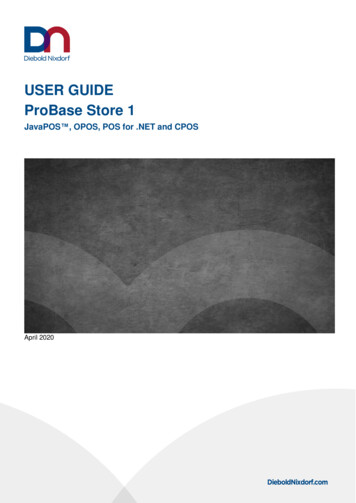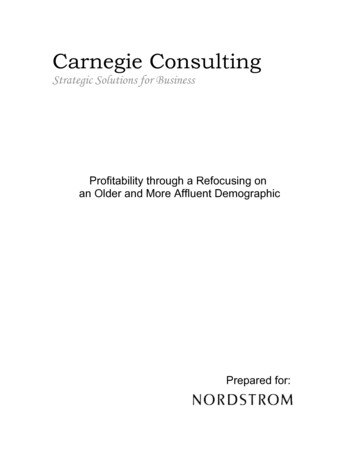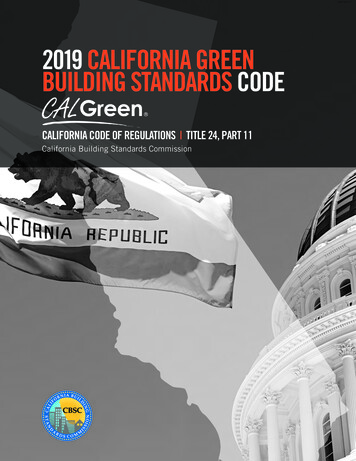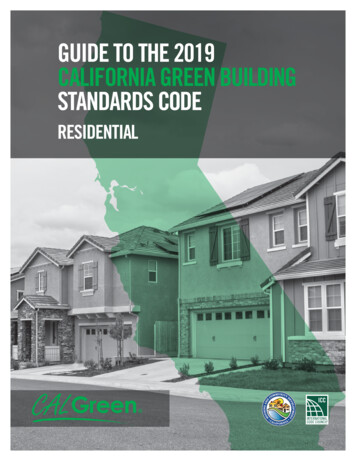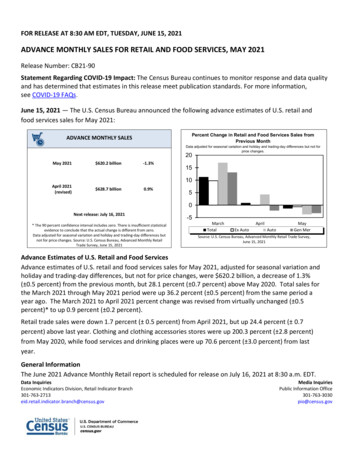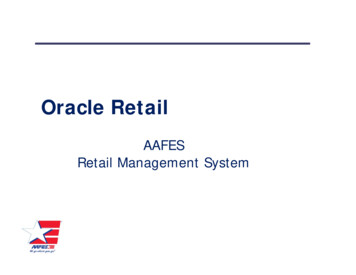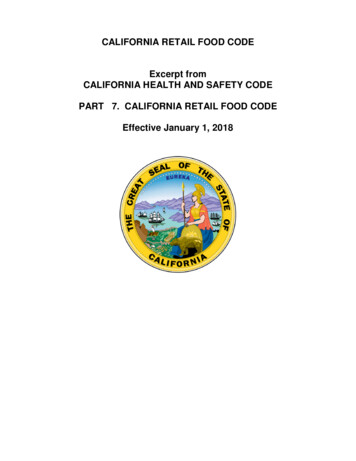
Transcription
CALIFORNIA RETAIL FOOD CODEExcerpt fromCALIFORNIA HEALTH AND SAFETY CODEPART 7. CALIFORNIA RETAIL FOOD CODEEffective January 1, 2018
California Retail Food CodeEffective January 1, 2018TABLE OF CONTENTSPAGESECTIONNUMBERCHAPTER 1. GENERAL PROVISIONS4113700CHAPTER 2 . DEFINITIONS6113728CHAPTER 3. MANAGEMENT AND PERSONNEL22Article 1 – SupervisionArticle 2 – Employee KnowledgeArticle 3 – Employee HealthArticle 4 – HandwashingArticle 5 – Personal CleanlinessArticle 6 – Hygienic Practices222227283131CHAPTER 4 . GENERAL FOOD SAFETY REQUIREMENTSArticle 1 – Protection from ContaminationArticle 2 – Time Temperature RelationshipsArticle 3 – Food from Approved SourcesArticle 4 – Receipt of FoodArticle 5 – Food StorageArticle 6 – Specialized Processing MethodsArticle 7 – Food Display and ServiceArticle 8 – Consumer 7114060114087CHAPTER 5 . CLEANING AND SANITIZING OF EQUIPMENTAND UTENSILS51114095CHAPTER 6. EQUIPMENT, UTENSILS, AND LINENS57Article 1 – Design and ConstructionArticle 2 – VentilationArticle 3 – Location and InstallationArticle 4 – Maintenance and OperationArticle 5 – Linens5760616364CHAPTER 7. WATER, PLUMBING, AND WASTE65Article 1 – WaterArticle 2 – Liquid WasteArticle 3 – Mobile Water and Wastewater TanksArticle 4 – Refuse65666669CHAPTER 8. PHYSICAL 9711420511424470Article 1 – Toilet FacilitiesArticle 2 – LightingArticle 3 – Poisonous and Toxic MaterialsArticle 4 – Employee Storage AreaArticle 5 – Premises and FacilitiesArticle 6 – Vermin and 114259
California Retail Food CodeEffective January 1, 6114279114285114289CHAPTER 10. MOBILE FOOD FACILITIES78114294CHAPTER 10.5. NONPROFIT CHARITABLE TEMPORARYFOOD FACILITIES84114332CHAPTER 11. TEMPORARY FOOD FACILITIES86114335CHAPTER 11.5. COTTAGE FOOD OPERATIONS88114365CHAPTER 12 .92114370CHAPTER 12.5. FARM STANDS AND COMMUNITYFOOD PRODUCTION93114375CHAPTER 12.6 . TRANS FATS95114377CHAPTER 12.7. FISHERMEN’S MARKETS96114378CHAPTER 13.97CHAPTER 9. PERMANENT FOOD FACILITIESArticle 1 – Floors, Walls, and CeilingsArticle 2 – Toilet FacilitiesArticle 3 – Janitorial FacilitiesArticle 4 – PremisesArticle 5 – Prepackaged Nonpotentially Hazardous FoodCERTIFIED FARMERS’ MARKETSCOMPLIANCE AND ENFORCEMENTArticle 1 – Plan Review and PermitsArticle 2 – EnforcementArticle 3 – Permit Suspension and RevocationArticle 4 – VarianceArticle 5 – HACCP ExemptionsArticle 6 – ExemptionsArticle 7 – Food Facility Food DonationsArticle 8 - Child Day Care Facilities, Community CareFacilities and Residential Care Facilities forthe 4417114419114425114432114437
California Retail Food CodeEffective January 1, 2018CHAPTER 1. GENERAL PROVISIONS113700. These provisions shall be known, and may be cited, as the California Retail Food Code,hereafter referred to as "this part."113703. The purpose of this part is to safeguard public health and provide to consumers food that issafe, unadulterated, and honestly presented through adoption of science-based standards.113705. The Legislature finds and declares that the public health interest requires that there beuniform statewide health and sanitation standards for retail food facilities to assure the people of thisstate that the food will be pure, safe, and unadulterated. Except as provided in Section 113709, it is theintent of the Legislature to occupy the whole field of health and sanitation standards for retail foodfacilities, and the standards set forth in this part and regulations adopted pursuant to this part shall beexclusive of all local health and sanitation standards relating to retail food facilities.113707. The department shall adopt regulations to implement and administer this part.113709. This part does not prohibit a local governing body from adopting an evaluation or gradingsystem for food facilities, from prohibiting any type of food facility, from adopting an employee healthcertification program, from regulating the provision of consumer toilet and handwashing facilities, or fromadopting requirements for the public safety regulating the type of vending and the time, place, andmanner of vending from vehicles upon a street pursuant to its authority under subdivision (b) of Section22455 of the Vehicle Code, or from prohibiting the presence of pet dogs in outdoor dining areas of foodfacilities.113711. In all laws and regulations, references to Chapter 4 (commencing with Section 113700) or theCalifornia Uniform Retail Food Facilities Law, shall mean this part or the California Retail Food Code.113713.(a) Primary responsibility for enforcement of this part shall be with the local enforcement agency.Nothing in this part shall prevent the department from taking any necessary program orenforcement actions for the protection of the public health and safety.(b) The department shall provide technical assistance, training, standardization, program evaluation,and other services to local health agencies as necessary to ensure the uniform interpretation andapplication of this part, when an appropriation is made to the department for this purpose.(c) Whenever the enforcement of the requirements of this part by any local enforcement agency issatisfactory to the department, the enforcement of this part shall not be duplicated by thedepartment. The department shall investigate to determine satisfactory enforcement of this partby evaluating the program of each local enforcement agency at least once every three years andshall prepare a report of the evaluation and list any program improvements needed only when anappropriation is made to the department for these purposes.113715. Any construction, alteration, remodeling, or operation of a food facility shall be approved bythe enforcement agency and shall be in accordance with all applicable local, state, and federal statutes,regulations, and ordinances, including but not limited to, fire, building, and zoning codes.113717.(a) Any person requesting the department to undertake any activity pursuant to paragraph (5) ofsubdivision (c) of Section 113871, Section 114417, paragraph (2) of subdivision (b) of Section114419, and Section 114419.3 shall pay the department's costs incurred in undertaking theactivity. The department's services shall be assessed at the current hourly cost-recovery rate,and it shall be entitled to recover any other costs reasonably and actually incurred in performingthose activities, including, but not limited to, the costs of additional inspection and laboratory4
California Retail Food Code(b)(c)Effective January 1, 2018testing. For purposes of this section, the department's hourly rate shall be adjusted annually inaccordance with Section 100425.The department shall provide to the person paying the required fee a statement, invoice, orsimilar document that describes in reasonable detail the costs paid.For purposes of this section only, the term "person" does not include any city, county, city andcounty, or other political subdivision of the state or local government.113718. Notwithstanding Section 16350 of the Government Code, all moneys deposited in the RetailFood Safety and Defense Fund shall be transferred to the Food Safety Fund for appropriation andexpenditure as specified by Section 110050.113719. Structural and sanitation requirements shall be based on the food service activity to beconducted, the type of food that is to be prepared or served, and the extent of food preparation that is tobe conducted at the food facility.113725.(a) The enforcement agency shall utilize a standardized food facility inspection format for food facilityinspections that includes all of the following:(1)The name and address of the food facility.(2)Identification of the following inspection criteria, which shall be the basis of the inspectionreport:(A)Improper holding temperatures of potentially hazardous foods.(B)Improper cooling of potentially hazardous foods.(C)Inadequate cooking of potentially hazardous foods.(D)Poor personal hygiene of food employees.(E)Contaminated equipment.(F)Food from unapproved sources.(3)For each violation identified pursuant to paragraph (2), classification of the violation as aminor violation or major violation.(b) An enforcement agency may modify the format to add criteria to those specified pursuant toparagraph (2) of subdivision (a), if both of the following conditions are met:(1)The additional criteria are based on other provisions of this part.(2)A violation is identified by reference to items and sections of this part, or the regulationsadopted pursuant to this part relating to those items, if a food facility is cited for a violationof the additional criteria.(c) This section shall not restrict the ability of the enforcement agency to inspect and report oncriteria other than those subject to regulation under this part.113725.1. A copy of the most recent routine inspection report conducted to assess compliance withthis part shall be maintained at the food facility and made available upon request. The food facility shallpost a notice advising consumers that a copy of the most recent routine inspection report is available forreview by any interested party.113725.2. Local enforcement agencies, and the department when adequate funding is madeavailable to the department, shall conduct routine training on food facility inspection standardization topromote the uniform application of inspection procedures.113725.3.(a) The department shall publish standardized procedures for enforcement agencies to report foodfacility inspection information regarding each food facility. The report shall include all of thefollowing:(1)Name and address of the food facility.(2)Date of last inspection.(3)Identification of any major violation identified in a food facility inspection.5
California Retail Food Code(b)Effective January 1, 2018(4)Reinspection date, if applicable.(5)Period of closure, if applicable.The department, in consultation with local environmental health directors, representatives of theretail food industry, and other interested parties, may periodically review and revise thestandardized procedures established pursuant to subdivision (a). In making any revisions, thedepartment shall strive to ensure that the required information can be reported and madeavailable in the most efficient, timely, and cost-effective manner.(c)(1)The standardized procedures established pursuant to this section shall include astandardized electronic format and protocol for reporting the food facility inspection data ina timely manner, and shall strive to ensure that the information is readily accessible, canbe rapidly reported, and, if necessary, corrected, for each food facility that has beeninspected or reinspected. If the enforcement agency determines that reported informationis materially in error, that error shall be corrected within 48 hours after that determination.(2)The department may establish standardized procedures for reporting the information onelectronic media, including, but not limited to, floppy disks or compact disks.(d) Within 60 days after the department has established the standardized procedures pursuant to thissection, the department shall publish these procedures.(e)(1)Each enforcement agency that reports food facility inspection information on an InternetWeb site shall report the information in accordance with the standardized proceduresestablished pursuant to this section.(2)This section shall not restrict the ability of an enforcement agency to report on mattersother than matters subject to regulation under this part.(f) The department may establish a link to each Internet Web site utilized by any enforcementagency containing the food facility inspection information pursuant to subdivision (e).CHAPTER 2. DEFINITIONS113728. The following definitions apply in the interpretation and application of this part.113729. "Food additive" has the meaning stated in Section 109940. "Color additive" has the meaningstated in Section 109895.113729.5. “Acceptable market name” means a name that the FDA recognizes as a suitable statementof identity, as described in Section 101.3 of Title 21 of the Code of Federal Regulations, in the labeling ofa species. An acceptable market name fairly represents the identity of the species to United Statesconsumers because it is not confusingly similar to the name of another species and because it is nototherwise misleading. An acceptable market name may be any of the following:(a) A common or usual name established by either a history of common usage in the United Statesor by regulation.(b) The common name.(c) A name specifically coined as the market name for a species. For example, “basa” is the marketname coined for Pangasius bocourti.113732. "Adulterated" means either of the following:(a) Food that bears or contains any poisonous or deleterious substance that may render the foodimpure or injurious to health.(b) Food that is manufactured, prepared, or stored in a manner that deviates from a HACCP plan soas to pose a discernable increase in risk.6
California Retail Food CodeEffective January 1, 2018113733. "Acute gastrointestinal illness" means a short duration illness most often characterized byeither of the following, which are known to be commonly associated with the agents most likely to betransmitted from infected food employees through contamination of food:(a) Diarrhea, either alone or in conjunction with other gastrointestinal symptoms, such as vomiting,fever, or abdominal cramps.(b) Vomiting in conjunction with either diarrhea or two other gastrointestinal symptoms, such as feveror abdominal cramps.113734. "Approved" means acceptable to the enforcement agency based on a determination ofconformity with applicable laws, or, in the absence of applicable laws, current public health principles,practices, and generally recognized industry standards that protect public health.113735.(a) "Approved source" means a food source allowed under Article 3 (commencing with Section114021) of Chapter 4, or a producer, manufacturer, distributor, or food facility that is acceptableto the enforcement agency based on a determination of conformity with applicable laws, or, in theabsence of applicable laws, with current public health principles and practices, and generallyrecognized industry standards that protect public health.(b)Any whole uncut fruit or vegetable or unrefrigerated shell egg grown or produced in compliancewith all applicable federal, state, or local laws, regulations, and food safety guidelines issued by aregulatory agency shall be deemed to be from an approved source.113737. "aw" means water activity that is a measure of the free moisture in a food, is the quotient ofthe water vapor pressure of the substance divided by the vapor pressure of pure water at the sametemperature, and is indicated by the symbol aw.113739. "Beverage" means a liquid for drinking, including water.113740. "CCR" means the California Code of Regulations.113742. "Certified farmers' market" means a location that is certified by the State of California throughthe enforcement officers of the county agricultural commissioners and operated pursuant to Chapter 10.5(commencing with Section 47000) of Division 17 of the Food and Agricultural Code and regulationsadopted pursuant to that chapter.113744. "C.F.R." means the Code of Federal Regulations. Citations in this part to the C.F.R. refersequentially to the title, part, and section numbers, such as 21 C.F.R. 178.1010 refers to Title 21, Part178, Section 1010.113747.(a) "CIP" means cleaned in place by the circulation or flowing by mechanical means through a pipingsystem of a detergent solution, water rinse, and sanitizing solution onto or over equipmentsurfaces that require cleaning, such as the method used, in part, to clean and sanitize a frozendessert machine.(b) "CIP" does not include the cleaning of equipment such as band saws, slicers, or mixers that aresubjected to in-place manual cleaning without the use of a CIP system.113747.1. “Cold water” means potable water that is not heated by an auxiliary method or source.113748. "Commingle" means:(a) To combine shellstock harvested on different days or from different growing areas as identified onthe tag or label.7
California Retail Food Code(b)Effective January 1, 2018To combine shucked shellfish from containers with different container codes or different shuckingdates.113750.(a) "Comminuted" means reduced in size by methods including chopping, flaking, grinding, ormincing.(b) "Comminuted" includes fish or meat products that are reduced in size and restructured orreformulated including, but not limited to, gefilte fish, formed roast beef, gyros, ground beef,sausage, and a mixture of two or more types of meat that have been reduced in size andcombined, including, but not limited to, sausages made from two or more meats.113751. "Commissary" means a food facility that services mobile food facilities, mobile support units,or vending machines where any of the following occur:(a)Food, containers, or supplies are stored.(b)Food is prepared or prepackaged for sale or service at other locations.(c)Utensils are cleaned.(d)Liquid and solid wastes are disposed, or potable water is obtained.113752. "Community food producer" means a producer of agricultural products on land that is notzoned for agricultural use but is otherwise in compliance with applicable local land use and zoningrestrictions, including, but not limited to, restrictions governing personal gardens, community gardens,school gardens, and culinary gardens.113755. “Community event” means an event conducted for not more than 25 consecutive ornonconsecutive days in a 90-day period and that is of a civic, political, public, or educational nature,including state and county fairs, city festivals, circuses, and other public gathering events approved bythe local enforcement agency.113756. "Condiment" means a nonpotentially hazardous food, such as relishes, spices, sauces,confections, or seasonings, that require no additional preparation, and that is used on a food item,including, but not limited to, ketchup, mustard, mayonnaise, sauerkraut, salsa, salt, sugar, pepper, orchile peppers.113757. "Consumer" means a person who is a member of the public, takes possession of food, is notfunctioning in the capacity of an operator of a food facility, and does not offer the food for resale.113758.(a) “Cottage food operation” means an enterprise that has not more than the amount in gross annualsales that is specified in this subdivision, is operated by a cottage food operator, and has notmore than one full-time equivalent cottage food employee, not including a family member orhousehold member of the cottage food operator, within the registered or permitted area of aprivate home where the cottage food operator resides and where cottage food products areprepared or packaged for direct, indirect, or direct and indirect sale to consumers pursuant to thispart. In 2013, the enterprise shall not have more than thirty-five thousand dollars ( 35,000) ingross annual sales in the calendar year. In 2014, the enterprise shall not have more than fortyfive thousand dollars ( 45,000) in gross annual sales in the calendar year. Commencing in 2015and each subsequent year thereafter, the enterprise shall not have more than fifty thousanddollars ( 50,000) in gross annual sales in the calendar year. A cottage food operation includesboth of the following:(1)A “Class A” cottage food operation, which is a cottage food operation that may engageonly in direct sales of cottage food products from the cottage food operation or other directsales venues described in paragraph (4) of subdivision (b).(2)A “Class B” cottage food operation, which is a cottage food operation that may engage inboth direct sales and indirect sales of cottage food products from the cottage food8
California Retail Food Code(b)Effective January 1, 2018operation, from direct sales venues described in paragraph (4) of subdivision (b), fromoffsite events, or from a third-party retail food facility described in paragraph (5) ofsubdivision (b).For purposes of this section, the following definitions shall apply:(1)“Cottage food employee” means an individual, paid or volunteer, who is involved in thepreparation, packaging, handling, and storage of a cottage food product, or otherwiseworks for the cottage food operation. An employee does not include an immediate familymember or household member of the cottage food operator.(2)“Cottage food operator” means an individual who operates a cottage food operation in hisor her private home and is the owner of the cottage food operation.(3)“Cottage food products” means nonpotentially hazardous foods, including foods that aredescribed in Section 114365.5 and that are prepared for sale in the kitchen of a cottagefood operation.(4)“Direct sale” means a transaction within the state between a cottage food operationoperator and a consumer, where the consumer purchases the cottage food productdirectly from the cottage food operation. Direct sales include, but are not limited to,transactions at holiday bazaars or other temporary events, such as bake sales or foodswaps, transactions at farm stands, certified farmers’ markets, or through communitysupported agriculture subscriptions, and transactions occurring in person in the cottagefood operation.(5)“Indirect sale” means an interaction between a cottage food operation, a third-partyretailer, and a consumer, where the consumer purchases cottage food products made bythe cottage food operation from a third-party retailer that holds a valid permit issuedpursuant to Section 114381. Indirect sales include, but are not limited to, sales made toretail shops or to retail food facilities where food may be immediately consumed on thepremises.(6)“Private home” means a dwelling, including an apartment or other leased space, whereindividuals reside.(7)“Registered or permitted area” means the portion of a private home that contains theprivate home’s kitchen used for the preparation, packaging, storage, or handling ofcottage food products and related ingredients or equipment, or both, and attached roomswithin the home that are used exclusively for storage.113759. "Control point" means any distinct procedure or step in receiving, storing, handling, preparing,displaying, transporting, or dispensing a food.113760. "Critical control point" means a point or procedure in a specific food system where loss ofcontrol may result in an unacceptable health risk.113761. "Critical limit" means the maximum or minimum value to which a physical, biological, orchemical parameter must be controlled at a critical control point to minimize the risk that the identifiedfood safety hazard may occur.113763. "Department" means the State Department of Health Services.113767. "Easily cleanable" means a characteristic of a surface that allows effective removal of soil,food residue, or other organic or inorganic materials by normal cleaning methods.113768. "Easily movable" means either of the following:(a) Portable; mounted on casters, gliders, or rollers so as to be moveable by one person; or providedwith a mechanical means to safely tilt or move a unit of equipment for cleaning.(b) Having no utility connection, a utility connection that disconnects quickly, or a flexible utilityconnection line of sufficient length to allow the equipment to be moved for cleaning of theequipment and adjacent area.9
California Retail Food CodeEffective January 1, 2018113769. "Egg" means the shell egg of an avian species that includes chicken, duck, goose, guinea,quail, ratite, or turkey, except a balut and an egg product. “Egg” does not include the egg of a reptilespecies, including an alligator.113770. "Employee" means the permitholder, person in charge, person having supervisory ormanagement duties, person on the payroll, family member, volunteer, person performing work undercontractual agreement, or other person working in a food facility.113773. "Enforcement agency" means the department or the local health agency having jurisdictionover the food facility.113774. "Enforcement officer" means the director, agents, or environmental health specialistsappointed by the Director of Health Services, and all local health officers, directors of environmentalhealth, and their duly authorized registered environmental health specialists and environmental healthspecialist trainees.113777.(a) "Equipment" means an article that is used in the operation of a food facility, including, but notlimited to, a freezer, grinder, hood, icemaker, meat block, mixer, oven, reach-in refrigerator, scale,food and utensil shelving and cabinets, sink, slicer, stove, table, temperature measuring devicefor ambient air, vending machine, or warewashing machine.(b) "Equipment" does not include items used for handling or storing large quantities of prepackagedfoods that are received from a supplier in a cased or overwrapped lot, such as hand trucks,forklifts, dollies, pallets, racks, and skids.113778. "Exclude" means to prevent a person from working as a food employee or entering a foodfacility except for those areas open to the general public.113778.1. "FDA" means the United States Food and Drug Administration.113778.2. "Farm stands" are premises, established in accordance with local ordinances and land usecodes, defined under and operated pursuant to Chapter 10.5 (commencing with Section 47000) ofDivision 17 of the Food and Agricultural Code and regulations adopted and enforced pursuant to thatchapter, operating within the requirements set forth in Sections 113789 and 114375.113778.4. “Fabric implement” means a cloth or fabric, including, but not limited to, burlap andcheesecloth, that is used as part of the food process and comes in direct contact with food that issubsequently cooked.113779.(a) “Fish” means fresh or saltwater finfish, crustaceans, and other forms of aquatic life, other thanbirds or mammals, and all molluscan shellfish, if intended for human consumption. “Fish” alsoincludes alligator, frog, aquatic turtle, jellyfish, sea cucumber, and sea urchin, and the roe ofthese animals.(b) “Fish” includes a product derived in whole or in part from fish, including fish that have beenprocessed in any manner.113780. “Fishermen’s market” means a location that is operated by a commercial fisherman licensedby the Department of Fish and Wildlife or an entity representing two or more California-licensedcommercial fishermen or California-licensed commercial fishermen and California-registeredaquaculturists, that sells only raw edible aquatic plants, raw fresh fish, or fresh frozen fish, caught bycommercial fishermen licensed by the Department of Fish and Wildlife or harvested by Californiaregistered aquaculturists, directly to consumers.10
California Retail Food CodeEffective January 1, 2018113781. "Food" means a raw, cooked, or processed edible substance, ice, beverage, an ingredientused or intended for use or for sale in whole or in part for human consumption, and chewing gum.113783. "Food bank" means a surplus food collection and distribution system operated andestablished to assist in bringing donated food to nonprofit charitable organizations and individuals for thepurposes of reducing hunger and supplying nutritional needs.113784. "Food compartment" means an enclosed space, including, but not limited to, an air pot,blender, bulk dispensing system, covered chafing dish, and covered ice bin, with all of the followingcharacteristics:(a)The space is defined by a physical barrier from the outside environment that completely enclosesall food, food-contact surfaces, and the handling of nonprepackaged food.(b)All access openings are equipped with tight-fitting closures, or one or more alternative barriersthat effectively protect the food from contamination, facilitate safe food handling, while minimizingexposure to the environment.(c)It is constructed from materials that are nontoxic, smooth, easily cleanable, and durable and isconstructed to facilitate the cleaning of the interior and exterior of the compartment.113786. "Food-contact surface" means either of the following:(a)A surface of equipment or a utensil with which food normally comes into contact.(b)A surface of equipment or a utensil from which food may drain, drip, or splash into a food or ontoa surface normally in contact with food.113788. "Food employee" means an employee working with food, food equipment or utensils, or foodcontact surfaces.113789.(a)“Food facility” means an operation that stores, prepares, packages, serves, vends, or otherwiseprovides food for human consumption at the retail level, including, but not limited to, the following:(1)An operation where food is consumed on or off the premises, regardless of whether thereis a charge for the food.(2)A place used in conjunction with the operations described in this subdivision, including,but not limited to, storage facilities for food-related utensils, equipment, and materials.(b) “Food facility” includes permanent and nonpermanent food facilities, including, but not limited to,the following:(1)Public and private school cafeterias.(2)Restricted food service facilities.(3)Licensed health care facilities, except as provided in paragraph (12) of subdivision (c).(4)Commissaries.(5)Mobile food facilities.(6)Mobile support units.(7)Temporary food facilities.(8)Vending machines.(9)Certified farmers’ markets, for purposes of permitting and enforcement pursuant toSection 114370.(10) Farm stands, for purposes of permitting and enforcement pursuant to Section 114375.(11) Fishermen’s markets.(c) “Food facility” does not include any of the following:(1)A cooperative arrangement wherein no permanent facilities are us
California Retail Food Code Effective January 1, 2018. 5 . testing. For purposes of this section, the department's hourly rate shall be adjusted annually in accordancewith Section 100425. (b) The department shall provide to th
